博文
【热点专题】模糊系统
|
The Need for Fuzzy AI
Jonathan M. Garibaldi 教授提出了一个不可区分的概念框架,作为计算机化决策支持系统评估的关键组成部分。案例研究表明,人类专家的表现并不完美,还有一些技术可以使模糊系统模拟包括可变性在内的人类水平的表现。
该文从两个方面论证了 “模糊人工智能” 的必要性:
(一) 模糊方法学 (在扎德模糊集和系统的技术意义上) 作为以知识为基础的系统来表示和推理不确定性的必要性;
(二)在评估人工智能系统时,需要模糊性(在非技术意义上),并接受不完美的性能。
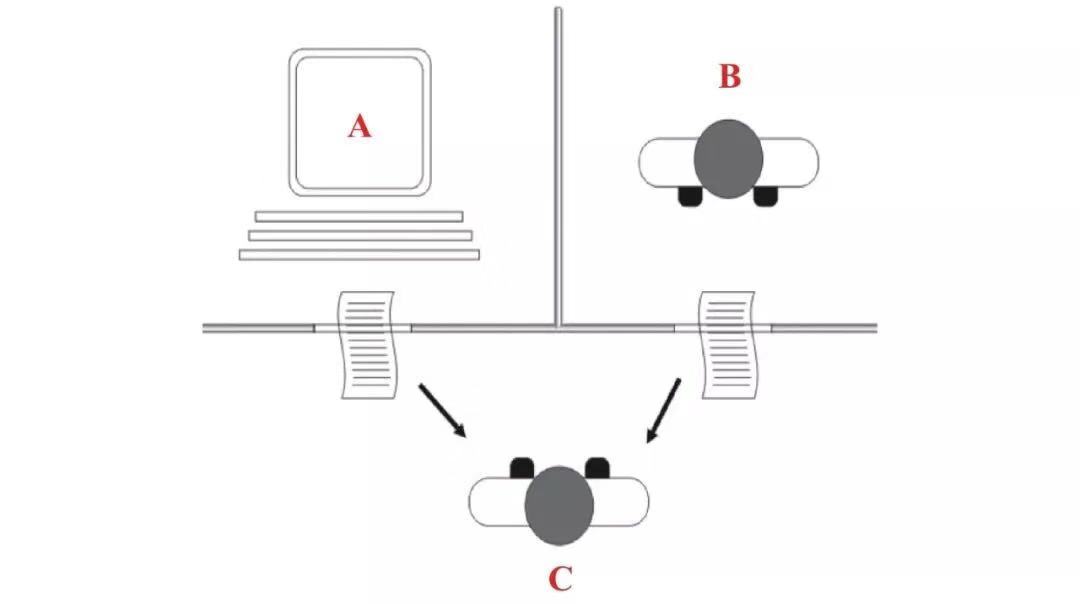
图灵测试的表示
Jonathan M. Garibaldi, "The Need for Fuzzy AI," IEEE/CAA J. Autom. Sinica, vol. 6, no. 3, pp. 610-622, May 2019.
http://www.ieee-jas.org/en/article/doi/10.1109/JAS.2019.1911465
Granular Computing for Data Analytics: A Manifesto of Human-Centric Computing
该文指出,粒计算是一种重要的人本计算,通过粒计算可以方便地实现并灵活调整抽象化水平。粒计算与信息粒的发展与处理紧密相关。针对可用的数据及其数据间的关系,利用信息粒可形成一种便利的知识组织方式。Pedrycz教授在该文中明确了粒计算的基本原则,归纳出信息粒构造的方式,并展示了如何利用信息粒刻画数据的内在关系。
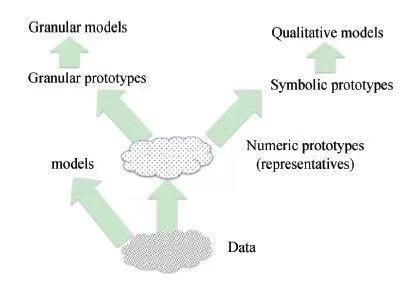
从数值型数据到粒模型建立的范式转换流程
Witold Pedrycz, "Granular Computing for Data Analytics: A Manifesto of Human-Centric Computing," IEEE/CAA J. Autom. Sinica, vol. 5, no. 6, pp. 1025-1034, Nov. 2018.
http://www.ieee-jas.org/en/article/doi/10.1109/JAS.2018.7511213
Adaptive Fuzzy Dynamic Surface Control of Flexible-Joint Robot Systems With Input Saturation
In this paper, we propose an adaptive fuzzy dynamic surface control (DSC) scheme for single-link flexible-joint robotic systems with input saturation. A smooth function is utilized with the mean-value theorem to deal with the difficulties associated with input saturation. An adaptive DSC design with an auxiliary first-order filter is used to solve the "explosion of complexity" problem.
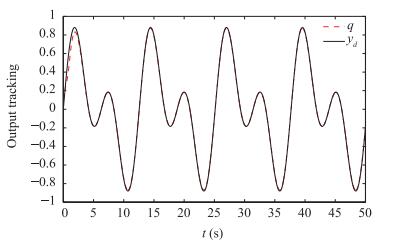
Trajectories of the link position qq and the desired trajectory ydyd.
Song Ling, Huanqing Wang and Peter X. Liu, "Adaptive Fuzzy Dynamic Surface Control of Flexible-Joint Robot Systems With Input Saturation," IEEE/CAA J. Autom. Sinica, vol. 6, no. 1, pp. 97-107, Jan. 2019.
http://www.ieee-jas.org/en/article/doi/10.1109/JAS.2019.1911330
Finite Frequency Fuzzy H∞ Control for Uncertain Active Suspension Systems With Sensor Failure
This paper investigates the problem of finite frequency fuzzy H∞ control for uncertain active vehicle suspension systems, in which sensor failure is taken into account. TakagiSugeno (T-S) fuzzy model is established for considered suspension systems. In order to describe the sensor fault effectively, a corresponding model is introduced. A vital performance index, H∞ performance, is utilized to measure the drive comfort.
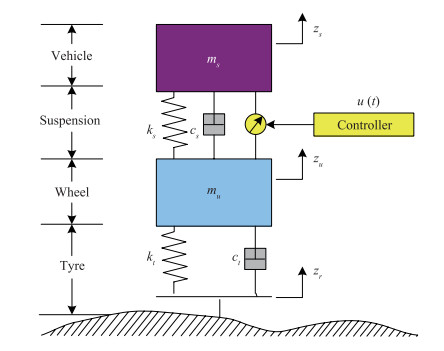
Quarter-vehicle model with an active suspension.
Zhenxing Zhang, Hongyi Li, Chengwei Wu and Qi Zhou, "Finite Frequency Fuzzy H∞ Control for Uncertain Active Suspension Systems With Sensor Failure," IEEE/CAA J. Autom. Sinica, vol. 5, no. 4, pp. 777-786, July 2018.
http://www.ieee-jas.org/en/article/doi/10.1109/JAS.2018.7511132
Modeling of Energy Consumption and Effluent Quality Using Density Peaks-based Adaptive Fuzzy Neural Network
To obtain suitable fuzzy rules, a DP-based clustering method is applied to fit the cluster centers to process nonlinearity. The parameters of the extracted fuzzy rules are fine-tuned based on the improved Levenberg-Marquardt algorithm during the training process. Furthermore, the analysis of convergence is performed to guarantee the successful application of the DPAFNN. Finally, the proposed DP-AFNN is utilized to develop the models of EC and EQ in the WWTP.
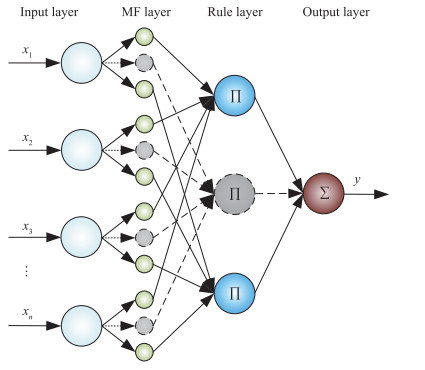
Architecture of the FNN.
Junfei Qiao and Hongbiao Zhou, "Modeling of Energy Consumption and Effluent Quality Using Density Peaks-based Adaptive Fuzzy Neural Network," IEEE/CAA J. Autom. Sinica, vol. 5, no. 5, pp. 968-976, Sep. 2018.
http://www.ieee-jas.org/en/article/doi/10.1109/JAS.2018.7511168
Parameter Optimization of Interval Type-2 Fuzzy Neural Networks Based on PSO and BBBC Methods
big bang-big crunch (BBBC) optimization and particle swarm optimization (PSO) are applied in the parameter optimization for Takagi-Sugeno-Kang (TSK) type IT2FNNs. The employment of the BBBC and PSO strategies can eliminate the need of backpropagation computation. The computing problem is converted to a simple feed-forward IT2FNNs learning. The adoption of the BBBC or the PSO will not only simplify the design of the IT2FNNs, but will also increase identification accuracy when compared with present methods.

Three types of the IT2FMFs.
Jiajun Wang and Tufan Kumbasar, "Parameter Optimization of Interval Type-2 Fuzzy Neural Networks Based on PSO and BBBC Methods," IEEE/CAA J. Autom. Sinica, vol. 6, no. 1, pp. 247-257, Jan. 2019.
http://www.ieee-jas.org/en/article/doi/10.1109/JAS.2019.1911348
Pythagorean Uncertain Linguistic Variable Hamy Mean Operator and Its Application to Multi-attribute Group Decision Making
This paper proposes a new multi-attribute group decision making method based on Pythagorean uncertain linguistic variable Hamy mean (PULVHM) operator and VIKOR method. Firstly, we define operation rules and a new aggregation operator of Pythagorean uncertain linguistic variable (PULV) and explore some properties of the operator. Secondly, taking the decision makers' hesitation degree into account, a new score function is defined, and we further develop a new group decision making approach integrated with VIKOR method. Finally, an investment example is demonstrated to elaborate the validity of the proposed method. Sensibility analysis and comprehensive comparisons with another two methods are performed to show the stability and advantage of our method.
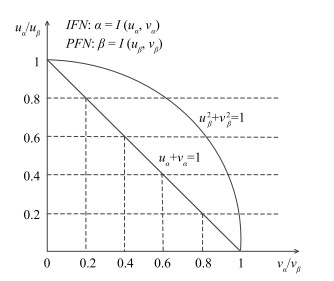
The space relationship of PFNs and IFNs memberships functions
Huidong Wang, Shifan He, Chengdong Li and Xiaohong Pan, "Pythagorean Uncertain Linguistic Variable Hamy Mean Operator and Its Application to Multi-attribute Group Decision Making," IEEE/CAA J. Autom. Sinica, vol. 6, no. 2, pp. 527-539, Mar. 2019.
http://www.ieee-jas.org/en/article/doi/10.1109/JAS.2019.1911408
A Mode-Switching Motion Control System for Reactive Interaction and Surface Following Using Industrial Robots
This work proposes a sensor-based control system for fully automated object detection and exploration (surface following) with a redundant industrial robot. The control system utilizes both offline and online trajectory planning for reactive interaction with objects of different shapes and color using RGBD vision and proximity/contact sensors feedback where no prior knowledge of the objects is available. The RGB-D sensor is used to collect raw 3D information of the environment. The data is then processed to segment an object of interest in the scene.
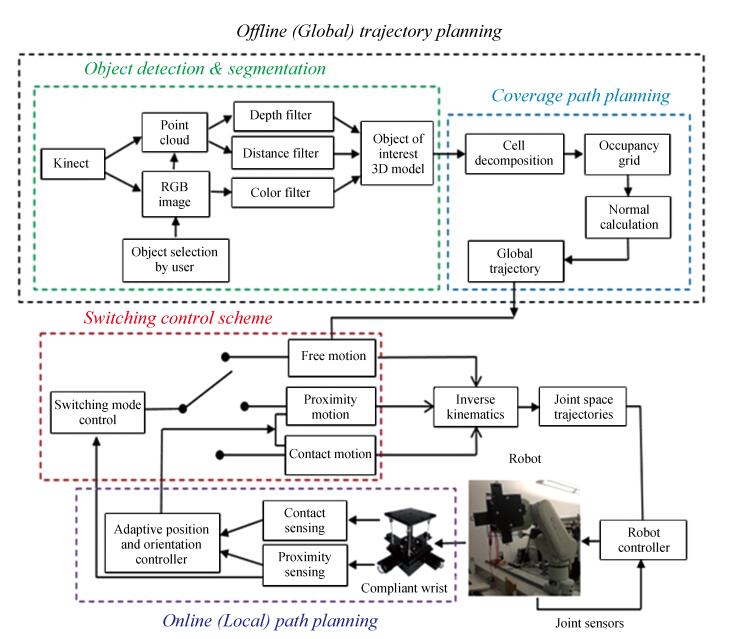
Block diagram of the proposed mode switching control system
Danial Nakhaeinia, Pierre Payeur and Robert Laganière, "A Mode-Switching Motion Control System for Reactive Interaction and Surface Following Using Industrial Robots," IEEE/CAA J. Autom. Sinica, vol. 5, no. 3, pp. 670-682, Mar. 2018.
http://www.ieee-jas.org/en/article/doi/10.1109/JAS.2018.7511069
基于区间二型模糊摩擦补偿的鲁棒自适应控制
本文提出基于自适应区间二型(Type-2)模糊逻辑系统对系统摩擦进行补偿建模,并在该摩擦补偿方法的基础上设计出鲁棒自适应控制器,保证系统输出精度,且对摩擦环境的变化具有较强自适应性.区间二型模糊逻辑系统相对于传统一型模糊逻辑系统具有较强的处理不确定性问题的能力,在本文中使用自适应区间二型模糊逻辑系统不断逼近摩擦力,根据李雅普诺夫稳定性理论求出自适应律并证明系统跟踪误差的有界性.
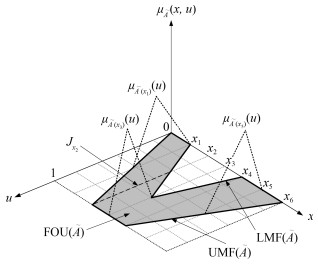
二型模糊集合的各元素
罗刚, 王永富, 柴天佑, 张化锴. 基于区间二型模糊摩擦补偿的鲁棒自适应控制. 自动化学报, 2019, 45(7): 1298-1306.
http://html.rhhz.net/ZDHXBZWB/html/2019-7-1298.htm
含齿隙弹载舵机的全局反步模糊自适应控制
针对制导弹药电动舵机伺服系统中存在的齿隙、不确定参数及外部干扰,提出一种基于反步法的全局模糊自适应控制方法.首先,综合考虑上述非线性因素,分析描述齿隙的近似死区模型,建立含齿隙弹载舵机的双惯量机电模型,并将其引入采用"三闭环"结构的伺服系统中,构建非线性系统的状态空间;然后,采用模糊逻辑系统对齿隙等非线性因素进行自适应逼近与补偿控制,通过反步递推构造全系统Lyapunov函数,并运用Lyapunov第二法证明了整个闭环系统最终一致有界.
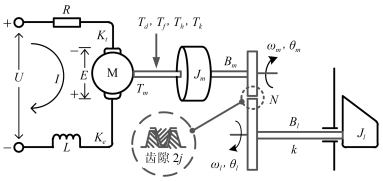
含齿隙双惯量机电模型
田福庆, 姜尚, 梁伟阁. 含齿隙弹载舵机的全局反步模糊自适应控制. 自动化学报, 2019, 45(6): 1177-1185.
http://html.rhhz.net/ZDHXBZWB/html/2019-6-1177.htm
基于区间二型T-S模糊模型的网络控制系统的输出反馈预测控制
针对干扰作用下的非线性网络控制系统,给出了带一个自由控制作用的输出反馈预测控制方法.首先,利用区间二型T-S模糊模型描述具有参数不确定性的非线性对象,采用马尔科夫链描述系统中的随机丢包过程,由此建立了丢包网络环境下的非线性网络控制系统的数学模型.然后,通过引入二次有界技术得到了干扰作用下网络控制系统的稳定性描述方法,并在此基础上给出了状态观测器的线性矩阵不等式条件.最后,基于估计状态,通过将无穷时域控制作用参数化为一个自由控制作用加一个线性反馈律得到了输出反馈预测控制方法.论文的特色在于构建了在线更新误差椭圆集合的基本方法,满足了约束条件下输出反馈预测控制保证稳定性的要求.仿真例子验证了所提方法的有效性.
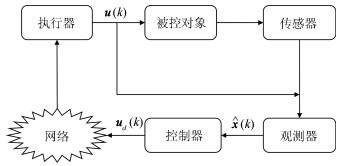
网络控制系统框图
唐晓铭, 邓梨, 虞继敏, 屈洪春. 基于区间二型T-S模糊模型的网络控制系统的输出反馈预测控制. 自动化学报, 2019, 45(3): 604-616.
http://html.rhhz.net/ZDHXBZWB/html/2019-3-604.htm
基于多维时态关联规则的演化模糊推理预测算法
本文提出了一个基于多维时态关联规则的演化模糊推理预测建模算法(Evolving fuzzy inference model based on multidimensional temporal association rules,EFI-MTAR),主要优势是构建了一种基于多维时态关联规则的模糊推理建模算法(Fuzzy inference modeling algorithm based on multidimensional temporal association rules,FI-MTAR),实现了对时间序列的定量预测.此外,为了降低规则更新的代价和加快规则预测的速度,提出了概念漂移检测策略来处理时间序列数据以适应数据库的动态更新.

滑动窗的实现过程
王玲, 孟建瑶, 李俊飞, 彭开香. 基于多维时态关联规则的演化模糊推理预测算法. 自动化学报, 2018, 44(8): 1446-1459.
http://html.rhhz.net/ZDHXBZWB/html/2018-8-1446.htm
模糊灰色认知网络的建模方法及应用
针对具有不确定性非线性系统的机理模型难以建立的问题,提出了基于模糊灰色认知网络(Fuzzy grey cognitive networks,FGCN)的非线性系统建模方法.该方法将模糊认知网络和灰色系统理论相结合,把模糊认知网络的节点状态值和权值扩展为灰色区间,引入灰度来评判可靠性.采用一种带终端约束的非线性Hebbian学习算法(Nonlinear hebbian learning,NHL)辨识FGCN的模型参数,引入了与FGCN模型中节点的系统实际测量值对应的灰数值,在更新机制中增加了包含系统测量值与预测值之差的修正项,对权值进行有监督的修正.

水箱控制过程
陈宁, 彭俊洁, 王磊, 郭宇骞, 桂卫华. 模糊灰色认知网络的建模方法及应用. 自动化学报, 2018, 44(7): 1227-1236.
http://html.rhhz.net/ZDHXBZWB/html/2018-7-1227.htm
基于模糊不确定观测器的四旋翼飞行器自适应动态面轨迹跟踪控制
针对具有未知外界扰动和系统不确定性的四旋翼飞行器,提出了一种基于模糊不确定观测器(Fuzzy uncertainty observer,FUO)的自适应动态面轨迹跟踪控制方法.通过将四旋翼飞行器系统分解为位置、姿态角和角速率三个动态子系统,使得各子系统虚拟控制器能够充分考虑欠驱动约束;采用一阶低通滤波器重构虚拟控制信号及其一阶导数,实现四旋翼跟踪控制设计的迭代解耦;设计了一种模糊不确定观测器,用以估计和补偿未知外界扰动与系统不确定性,从而确保闭环系统的稳定性和跟踪误差与其他系统信号的一致有界性.
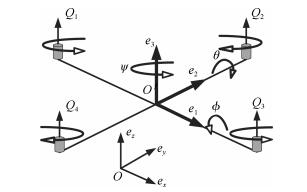
四旋翼飞行器结构图
王宁, 王永. 基于模糊不确定观测器的四旋翼飞行器自适应动态面轨迹跟踪控制. 自动化学报, 2018, 44(4): 685-695.
http://html.rhhz.net/ZDHXBZWB/html/2018-4-685.htm
基于深度学习和模糊C均值的心电信号分类方法
针对长时海量心电信号自动分类系统中,心电专家诊断费时、费力和成本高,心电信号形态复杂导致特征提取困难,异常诊断模型适应性差、准确度低等问题,本文提出一种基于深度学习和模糊C均值的心电信号分类方法.该方法主要包括心电信号降噪预处理、心电信号分段和采样点统一化、无监督心跳特征学习、模糊C均值分类4个步骤,给出了模糊C均值深度信念网络FCMDBN模型结构和学习分类算法.
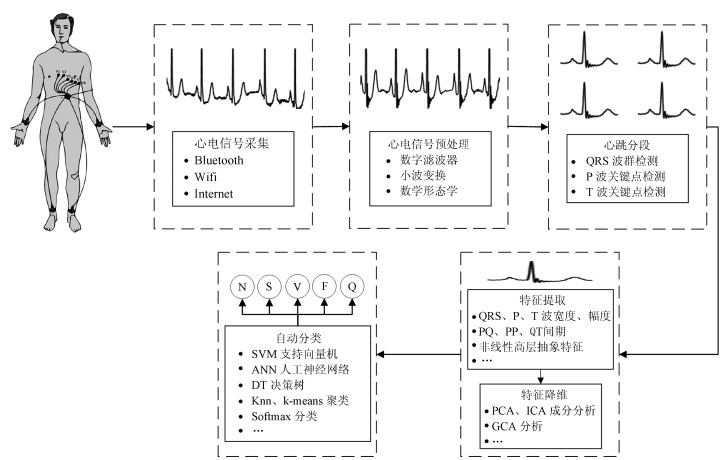
心电信号自动分类系统流程
吴志勇, 丁香乾, 许晓伟, 鞠传香. 基于深度学习和模糊C均值的心电信号分类方法. 自动化学报, 2018, 44(10): 1913-1920.
http://html.rhhz.net/ZDHXBZWB/html/2018-10-1913.htm
https://blog.sciencenet.cn/blog-3291369-1193002.html
上一篇:西北工业大学潘泉教授等:信息融合理论研究进展:基于变分贝叶斯的联合优化
下一篇:大连理工王伟教授等:基于迁移学习的类别级物体识别与检测研究与进展